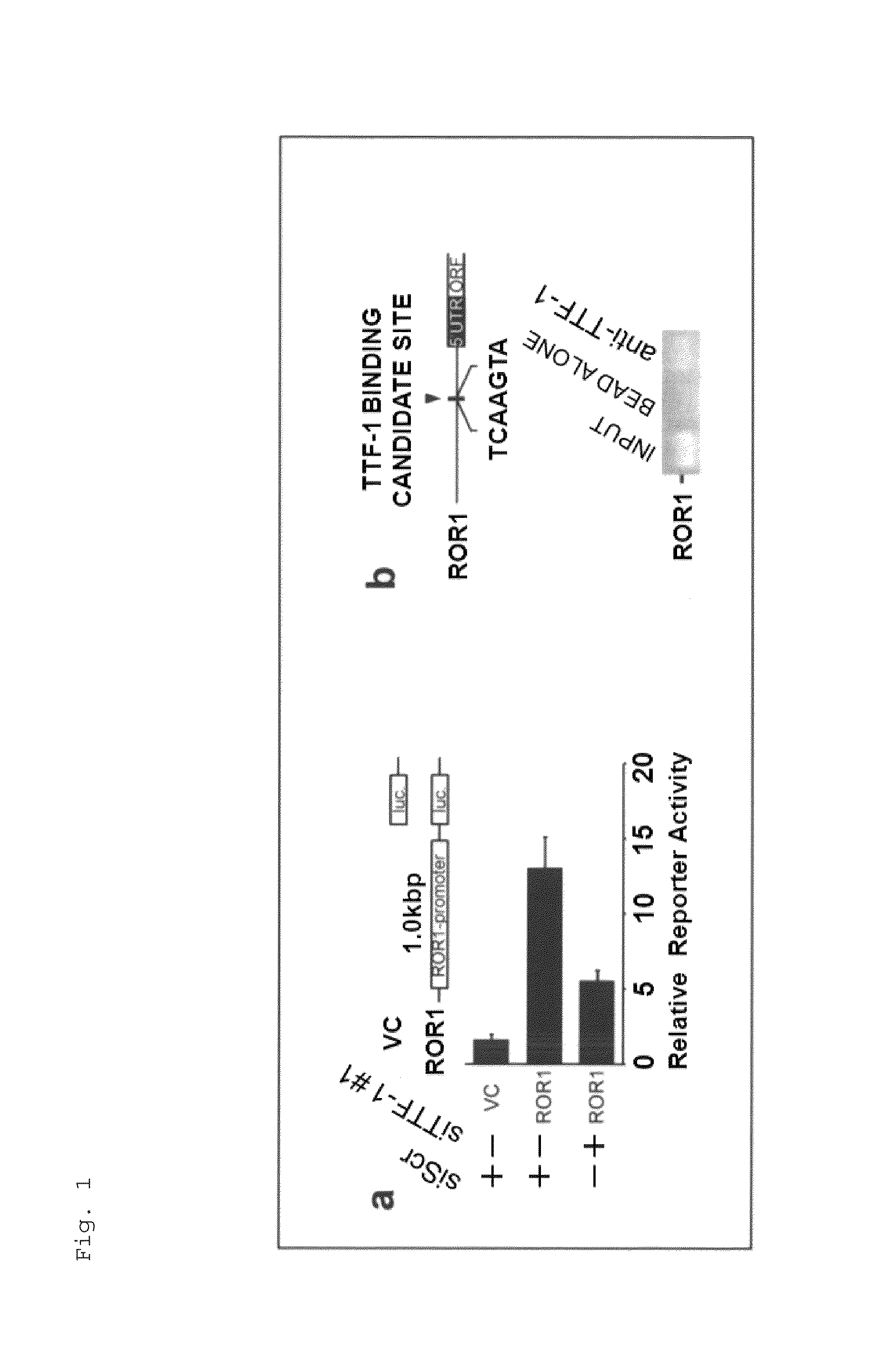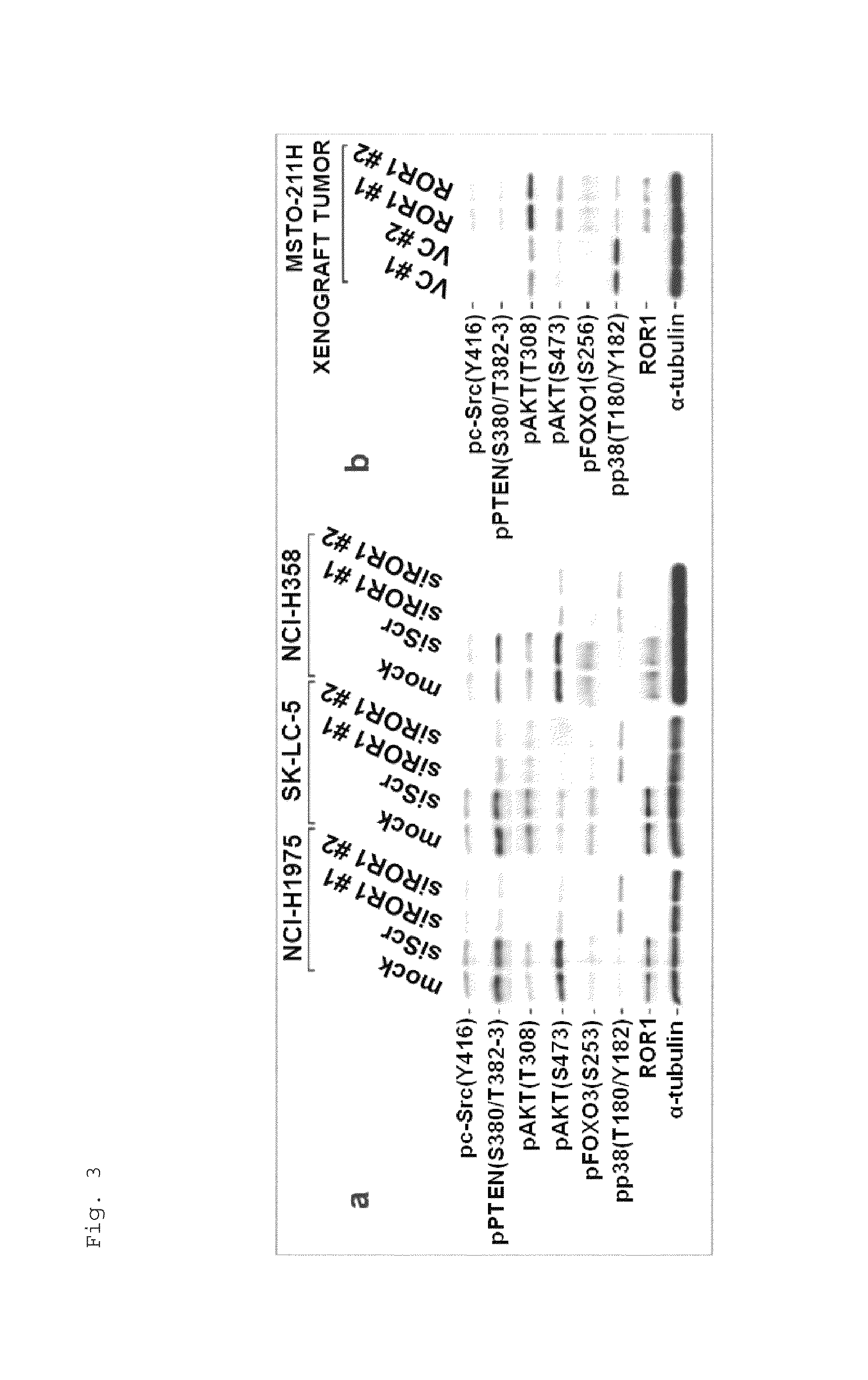Method for suppressing receptor tyrosine kinase-mediated pro-survival signaling in cancer cell
a receptor tyrosine kinase and cancer cell technology, applied in the field of suppressing pro-survival signaling in cancer cells, can solve the problems of little research on the mechanism of how ror1 suppresses cancer cell growth, and the death of cancer patients in economically well-developed countries, so as to suppress pro-survival signaling, suppress pro-survival signaling, and effectively suppress cancer cell growth
- Summary
- Abstract
- Description
- Claims
- Application Information
AI Technical Summary
Benefits of technology
Problems solved by technology
Method used
Image
Examples
example 1
Identification of ROR1 Involved in Lineage-Specific Survival Signaling by TTF-1
[0140]The luciferase reporter assay utilizing a region near 1.0-kb of the human ROR1 gene promoter showed the activation was dependent on TTF-1 (a in FIG. 1). The chromatin immunoprecipitation assay revealed that TTF-1 directly bound to the ROR1 gene promoter (b in FIG. 1). These results indicated that ROR1 was a transcription target of TTF-1.
example 2
Verification of Influence on Lung Adenocarcinoma Cell Growth by ROR1 Expression Suppression or Expression Enhancement
[0141]The in vivo treatment by administering ROR1 siRNA with atelocollagen into the tumors significantly reduced the growth of the xenograft tumor from NCI-H1975 (a in FIG. 2).
[0142]Meanwhile, the growth of the TTF-1+ / ROR1+NCI-H358 cells having been suppressed to a substantial degree by the short hairpin TTF-1 (shTTF-1) expression was significantly restored by co-expressing ROR1 (b in FIG. 2). This suggests that ROR1 induced by TTF-1 be a quite important mediator located downstream of survival signaling by TTF-1.
[0143]Further, the in vivo growth of the xenograft tumor from the ROR1-negative MSTO-211H cells was enhanced by exogenously expressing ROR1 at a level equivalent to that of the NCI-H358 cells (c in FIG. 2).
example 3
Identification of Downstream Molecules in ROR1-Mediated Signal Transduction
[0144]Next, in order to elucidate the ROR1-mediated signal transduction, potential downstream molecules were analyzed by the western blotting analysis.
[0145]Suppressing ROR1 reduced phosphorylation of c-Src, PTEN, AKT, and FOXO1, but enhanced phosphorylation of p38 (a in FIG. 3). Meanwhile, the xenograft tumor derived from ROR1-introduced MSTO-211H cells demonstrated opposite effects (b in FIG. 3).
[0146]These findings match an “oncogenic shock” model, in which rapid inhibition of oncogenic signal transduction unbalances pro-survival signaling and pro-apoptotic signaling, consequently leading to cell death.
[0147]ROR1-positive lung adenocarcinoma cell lines are dependent on ROR1-mediated survival signaling in this manner. If the signaling is inhibited, apoptotic reactions would be sequentially induced.
PUM
| Property | Measurement | Unit |
|---|---|---|
| volume | aaaaa | aaaaa |
| volume | aaaaa | aaaaa |
| resistance | aaaaa | aaaaa |
Abstract
Description
Claims
Application Information
 Login to View More
Login to View More - R&D
- Intellectual Property
- Life Sciences
- Materials
- Tech Scout
- Unparalleled Data Quality
- Higher Quality Content
- 60% Fewer Hallucinations
Browse by: Latest US Patents, China's latest patents, Technical Efficacy Thesaurus, Application Domain, Technology Topic, Popular Technical Reports.
© 2025 PatSnap. All rights reserved.Legal|Privacy policy|Modern Slavery Act Transparency Statement|Sitemap|About US| Contact US: help@patsnap.com



